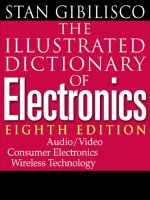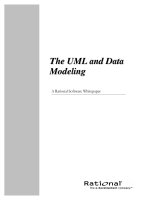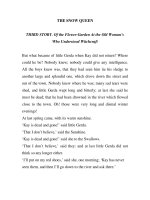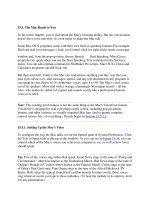Tài liệu THE BRONZE AGE IN IRELAND pptx
Bạn đang xem bản rút gọn của tài liệu. Xem và tải ngay bản đầy đủ của tài liệu tại đây (7.17 MB, 117 trang )
THE BRONZE AGE IN IRELAND
THE BRONZE AGE
IN IRELAND
BY
GEORGE COFFEY
MEMBER OF THE ROYAL IRISH ACADEMY
HONORARY FELLOW OF THE ROYAL SOCIETY OF ANTIQUARIES OF
IRELAND
KEEPER OF IRISH ANTIQUITIES IN THE NATIONAL MUSEUM
AND PROFESSOR R.H.A. DUBLIN
WITH ELEVEN PLATES AND EIGHTY-FIVE ILLUSTRATIONS
HODGES, FIGGIS, & CO., Limited,
104 GRAFTON STREET, DUBLIN
SIMPKIN, MARSHALL, & CO.,
LONDON
1913
Printed at the
By Ponsonby and Gibbs.
PREFACE
In this book on the Bronze Age in Ireland I have collected and collated all my work on
the period. Much of it I have already published in the “Proceedings of the Royal Irish
Academy” and elsewhere. I have long felt the need of a book on the Bronze Age in
Ireland, as hitherto none has appeared dealing adequately with the archæology of that
period in this country.
Within the last few years it has been recognized that the Bronze-Age civilization in
Europe did not consist of a series of isolated communities, each developing its own
type of objects and decorations, but that there was a community of ideas and forms
extending from Mycenæ all over the European continent.
I have described the various forms of Bronze-Age implements of peace and of war
found in Ireland, and have shown how they are connected with similar types on the
continent of Europe. M. J. Déchelette, of the Roanne Museum, one of the first
authorities on the Bronze Age, agrees with me in ascribing a Mycenæan origin to
certain forms of Bronze-Age implements.
How this Mycenæan influence penetrated to Ireland is a matter on which there is some
difference of opinion, and possibly new discoveries may throw additional light on the
problem. As I have shown both in this and in former works, the most probable route
seems to be that of the Danube and the Elbe, and thence by way of Scandinavia to
Ireland. It is to be hoped that now—with a concentrating of Irish interests on Irish
affairs a new impetus will be given to the study of the history of our country, and that
many workers may be found in the fields of archæology and of all subjects connected
with our past.
In my “Guide to the Celtic Antiquities of the Christian Period” I have given the
history of Irish art in the Christian period; in “New Grange (Brugh na Boine) and
other Incised Tumuli in Ireland, the influence of Crete and the Ægean in the extreme
west of Europe in early times,” I have given as much as is known of the pre-Christian
period up to the Bronze Age; and in this, my latest work, which has been much
interrupted by illness, I have endeavoured to complete the history of ancient art in
Ireland.
I have to thank the Councils of the Royal Irish Academy and of the Royal Society of
Antiquaries of Ireland for the loan of a number of blocks. In other cases drawings
have been made direct from objects in the National Museum by Miss E. Barnes.
The plates are from photographs taken by the photographer of the National Museum.
In offering this book to the public I must express my gratitude to Mr. E. C. R.
Armstrong, to whom I am indebted for his unvarying kindness and sympathy, and for
much valuable assistance both in the matter and form of the work.
GEORGE
COFFEY.
CONTENTS
page
Chapter I, 1
Introduction; Chronology of the Irish Bronze Age.
Chapter II, 6
Transitional Copper Period; Localities where native copper is found in Ireland; Finds
of copper celts; Moulds for casting flat celts; List of localities where Irish copper celts
have been found; Halberds; Localities where found; Types; Analyses; Continental
examples; Probable derivation of Irish halberds from Spain.
Chapter III, 23
First and later periods of the Bronze Age; Evolution of the bronze celt; Ornamentation
of bronze celts; Palstave with double loops; Anvil and hammers; Spear-heads;
Evolution from the knife-dagger; Type derived from the rapier; Leaf-shaped spear-
heads; Spear-heads with apertures in the blade; Moulds for casting spear-heads;
Ferules for spear-butts.
Chapter IV, 46
Irish gold: Account of Irish gold deposits; Lunulæ: General description of;
Distribution.
Chapter V, 56
Daggers and rapiers; Evolution of the dagger and rapier blade; Handles of daggers and
rapiers.
Chapter VI, 62
Gold gorgets; Gold sun-disks; Gold balls; Clare find; Penannular rings and ring-
money; Ring-money.
Chapter VII, 71
Leaf-shaped swords; Division of types; Absence of moulds for casting; Bronze
chapes; Winged chapes; Shields; Circular bronze shields; Shield of wood; Leather
Shield.
Chapter VIII, 78
Torcs; Twisted torcs; Distribution of torcs; Ribbon torcs; Plain torcs.
Chapter IX, 80
Bronze-age finds; List of well-authenticated Irish finds.
Chapter X, 88
Bronze trumpets; Types and derivation of Irish trumpets; Sickles; Discussion of types;
Importance of, with regard to date of agriculture; Disk-headed pins.
Chapter XI, 94
Bronze-age pottery; Food-vessels; Derivation of, from Neolithic type; Cinerary urns;
Incense cups.
Chapter XII, 101
Bronze-age ornamentation in Ireland; Discussion of the ornamentation at New
Grange; M. Déchelette’s views as to its origin compared with those of the author.
Index, 105
LIST OF ILLUSTRATIONS
Fig.
Page
1. Copper Halbert, Birr find, 7
2. Copper celts, Birr find, 8
3. Copper knife and awls found at Knocknague, 9
4. Copper celts, 10
5. Copper celts from Cappeen, Co. Cork, 11
6. Stone mould for casting celts, 12
7. Halbert blades, 13
8. Halbert blades, 14
9. Halbert blades, 15
10. Halbert blades, 16
11. Halberts from North Germany and Sweden, 18
12. Halberts from South and East Spain, 19
13. Rock markings, Maritime Alps, 20
14. Stone pick from the Bann, 21
15. Deer-horn pick, 21
16. Ornamented bronze celts, 24
Plate I, Irish bronze celts in the order of their development, 24
17. Ornamented bronze celts, 25
18. Ornamented bronze celts, 26
19. Winged celt, 27
20. Winged celt, 27
21. Palstave with double loops, 27
22. Bronze anvil, 28
23. Bronze hammers, 28
24. Dagger and spear-heads, 29
25. Spear-heads, 30
26. Spear-heads, 31
27. Rapier and spear-head, 31
28. Leaf-shaped spear-heads, 32
29. Ornamented socket of spear-head, 32
30. Leaf-shaped spear-heads found at the Ford, Belturbet, 33
31. Spear-heads with loops joining the blade, 34
32. Spear-heads, 34
33. Ornamental spear-heads, with openings in the blade, 35
34. Portion of spear-head, with studs at the base of the wings, 35
35. Spear-heads with openings in the blades, 36
36. Spear-heads with ornamental loops in the blades, 37
37. Spear-head found at Tempo, Co. Fermanagh, 37
38. Half of mould for casting a socketed spear-head, Killymeddy, Co. Antrim, 38
39.
Half of mould for casting a spear-
head and dagger, Killymeddy, Co.
Antrim,
39
40. Mould for casting a spear-head and knife, Killymeddy, Co. Antrim, 40
41. Moulds for casting primitive spear-heads found in Co. Tyrone, 41
42. Moulds for casting primitive spear-heads found in Co. Tyrone, 42
43. Half of mould for casting spear-head and dagger, Killymeddy, Co. Antrim, 43
44. Bronze spear-ferules, 44
45. Bronze spear-ferule with La Tène ornament, 44
46. Gold lunula found at Trenta, Carrigans, Co. Donegal, 47
47. Gold lunula found in Co. Galway, 48
48. Gold lunula, 49
49. Gold lunula found at Killarney, 50
50. Oak case for lunula found at Newtown, Co. Cavan, 51
51. Gold lunula found at Valognes, Manche, 51
52. Gold lunula found in Co. Londonderry, 52
53. Gold lunula found at Athlone, 54
54. Map showing the distribution of gold lunulæ in Ireland and Europe, 55
55.
Stone celt, bronze dagger with gol
d band, and urn, found in Topped
Mountain
Cairn, Co. Fermanagh,
56
56. Dagger and rapier blades, 57
57. Dagger with horn handle found at Ballymoney, Co. Antrim, 59
58. Rapier found in Upper Lough Erne, 59
59. Rapier found at Lissane, Co. Derry, 59
60. Rapiers and daggers found in Ireland, 61
61.
Gold gorget found in Ireland, formerly in
the possession of the Earl of
Charleville,
62
Plate II, Irish gold gorgets, 62
Plate III, gold sun-disks, 64
Plate IV, portion of the great Clare find, 66
62. Gold fibulæ and other objects found together at Coachford, Co. Cork, 67
Plate V, gold fibulæ, 68
63.
Sixteenth-century
bronze casting from Benin, showing Europeans holding
manillas,
68
64. Sixteenth-
century bronze casting from Benin, showing natives holding
69
manillas,
Plate VI, gold ring-money, 70
65.
Leaf-shaped bronze swords found with a spear-
head at Tempo, Co.
Fermanagh,
72
66. Bronze chapes, 73
67. Winged chapes, 73
68. Bronze shield found at Lough Gur, Co. Limerick, 74
69. Alder-wood shield found in Co. Leitrim, 75
70. Front and back of leather shield, found at Clonbrin, Co. Longford, 76
Plate VII, gold torcs from Tara and elsewhere, 78
Plate VIII, gold torcs, 78
Plate IX, gold torcs from Clonmacnois and Broighter, 80
71. Two late Bronze-Age finds, 83
72. Late Bronze-Age horse-hair fabrics from Armoy, Co. Antrim, 84
73. Bronze implements, Co. Tipperary, 85
74. Bronze implements found at Kilfeakle, Co. Tipperary, 86
Plate X, bronze trumpets, 88
75. Mould for casting a sickle, found at Killymeddy, Co. Antrim, 89
76. Bronze sickles, 90
77. Bronze sickles, 91
78. Bronze disk, 92
79. Bronze button, 92
80. Incense cup, 94
81. Cinerary urn, 94
82. Food-vessel with cover, Danesfort, Co. Kilkenny, 95
83. Cinerary urn, Carballybeg, Co. Waterford, 96
Plate XI, food-vessels in the order of their development, 96
84. Model of cinerary urn from Greenhills, Co. Dublin, 97
85. Cinerary urn, Cookstown, Co. Tyrone, 98
THE BRONZE AGE IN IRELAND
———————
CHAPTER I
Introduction
This book deals with the Bronze Age principally from the point of view of the
implements and weapons in use in Ireland during that period. It is unnecessary to state
that the materials for writing anything like a full account of the civilization or political
organization during the Bronze Age do not exist; and even the ethnological affinities
of the dominant race that inhabited Ireland during this period are doubtful. All that can
be said is that there was apparently no gap between the end of the Neolithic Period
and the transitional Copper to Bronze Period. Stone weapons continued in use side by
side with those of copper and bronze; and the form of the former was sometimes
actually influenced by those of the latter.
There has been so little scientific excavation in Ireland that the question as to the early
burial-customs is surrounded with difficulty; such evidence as there is points to
cremation having been practised early, as was also the case in Great Britain. Instances
show that the two rites of inhumation and cremation were practised side by side.
In the cairn excavated on Belmore Mountain, County Fermanagh, both burnt and
unburnt interments were found with pottery and other objects of early Bronze-Age
type.[1] At a recent excavation near Naas, County Kildare, a burnt interment was
discovered in a cist, the remains being associated with a wrist-bracer and remains of
pottery.[2] In the fine series of cairns on Carrowkeel Mountain, County Sligo, burnt
and unburnt interments were found associated with pottery, bone implements, and
stone beads.[3] At Annaghkeen, County Galway, a cremated burial was discovered in
a cist associated with pottery and a small bronze knife-dagger and awl.[4]
The Hon. John Abercromby gives a list of food-vessels found with cremated burials in
Ireland, and to these must be added a food-vessel of early type found in 1912 in a
quarry at Crumlin, County Dublin. It must, however, be left for future excavations to
decide many questions to which at present no answer, or only a doubtful one, can be
given. This, however, is certain—Ireland during the Bronze Age was not isolated, but
stood in direct communication with the Continent. Ægean and Scandinavian
influences can be detected in the great tumuli of the New Grange group[5]; and
Iberian influence is discernible in some of the later types of bronze implements.
Ireland, as will be shown in the chapters dealing directly with the gold objects, was,
during the Bronze Age, a kind of western El Dorado, owing to her great richness in
gold; Irish gold ornaments have been found both on the Continent and in Scandinavia;
while Scandinavian amber has been found in Ireland. As will be seen on p. 81, the
Bronze-Age people were acquainted with the art of weaving; and fine ornaments of
horse-hair were sometimes used. The art of making pottery by hand was carried to a
high degree of excellence. Shaving must have been fairly common, judging by the
number of bronze razors found. We shall find evidence further on in this work to show
that corn was probably grown and agriculture fairly advanced.
The great tumuli at New Grange and the lesser ones at Carrowkeel show that the art of
building was well developed, and that the religious ideals of the people had attained a
certain fixed form. What the actual dwellings occupied by the people were we cannot
say; but it is probable that many of the promontory-forts and some at least of the
larger cashels and ring-forts date back to this period. There remain, however, many
questions which, as we have said, must be kept over for future investigations.
The Chronology of the Irish Bronze Age
Some discussion as to the absolute chronology of the Bronze Age in Ireland will, no
doubt, be expected, though any attempts to give actual dates can only be approximate;
the succession of types is really of considerably more importance than the actual date,
as such a succession enables objects, finds, and interments to be arranged in a
progressive series, and shows the general trend of advance and culture. The doyen of
prehistoric archæology, Dr. Oscar Montelius, of Stockholm, has been the pioneer of
the study of the prehistoric chronology of Europe, his chronology of the Bronze Age
in Scandinavia having been published as far back as 1885. Since then he has published
the results of his studies of the Bronze-Age chronologies of Greece and Italy, and of
France, Belgium, South Germany, and Switzerland. More recently (1908) he has put
forward the chronology of the British Islands in a notable memoir published in
Archæologia. It may be mentioned that Dr. Montelius visited Ireland some years ago,
and speaks with the greater authority as having personally examined the actual Irish
evidence.
In this memoir Dr. Montelius divides the Bronze Age of Great Britain and Ireland into
five periods, and includes in his first period the transitional time when copper was in
use (Copper Period), which he places at from the middle of the third to the beginning
of the second millennium b.c. Now, though the division of the Irish Bronze Age into
five periods may be accepted, we should hardly care to place the first period as early
as Dr. Montelius suggests; and without going into the question of the time at which
the period commenced, we might take the period of its ending at from about 2000-
1800 b.c. In this period would be included the flat copper celts of early form, copied
from the stone celts of the preceding Neolithic Period, some few small, flat knife-
daggers of copper, and the earliest of the halberds. Stone implements, no doubt,
remained largely in use; and the very finely decorated hammer-axes probably belong
to this period.
It is possible that gold—which, on account of its colour and appearance on the surface
of the ground, must have been one of the metals first noticed and made use of in
prehistoric times—was used for making ornaments at this period, or possibly, as Prof.
Gowland suggests, may have been hammered into ornaments even during the
preceding Neolithic Age.[6] There is, however, no gold object in the National
Collection which we should care to place so early.
The second division of the Bronze Age (the first period of the true Bronze Age) would
fall between 1800 and 1500 b.c.; and in it would be included, as the principal types,
the flat bronze celts—including those with the edge much wider than the blade—
flanged celts, small bronze daggers, the later halberds, jet buttons with conical
perforations, and the early types of jet necklaces, and probably the gold lunulæ.
The third period might be placed at from 1500 to 1250 b.c., and the principal types
falling within it are flanged celts with stop-ridges, tanged spear-heads, and larger
dagger-blades, sometimes with bronze handles.
The fourth period, which was long, and during which a considerable development
takes place, might be placed at from 1280 to 900 b.c. This period includes the later
type of celts with increased stop-ridge and flanges (palstaves), and some of the earlier
forms of socketed celts, long rapiers, the earlier type of leaf-shaped swords, and the
looped and leaf-shaped spear-heads, gold torcs, and possibly some of the bronze
fibulæ, and sickles without sockets; the disk-headed pins and bronze razors may be
placed either at the end of this time or the beginning of the next period. In this period
must also be placed the building of the great tumuli of the New Grange group.
The fifth division—also a long one—would go from 900 to about 350 b.c., at which
time iron weapons were probably coming into general use in Ireland. In this period
would fall the socketed celts, including the latest type, which takes a form not
uncommon among iron or steel axes, the later bronze swords with notches below the
blades, bronze sword-chapes, the socketed sickles, probably some of the more highly
ornamented bronze spears with apertures in the blades, the bronze trumpets, the gold
fibulæ, and gold gorgets. It must be remembered that the Continental Hallstatt period
is not at present well represented in Great Britain and Ireland, and though, under
Hallstatt influence, certain Continental Iron-Age types such as bronze caldrons,
trumpets, round shields, &c., found their way into Ireland, we cannot as yet definitely
separate this period from the end of the Bronze Age.
CHAPTER II
Transitional Copper Period
In Ireland the metal first used was copper. Native copper is plentiful in Ireland, and
has been chiefly obtained from the Counties of Wicklow, Waterford, Cork, Kerry,
Tipperary, and Galway. In Waterford stone implements have been found in copper
mines in ancient workings, showing copper was mined for at an early period.[7] The
time during which copper was in use was probably relatively only a short one, much
shorter than the Neolithic Period or than the true Bronze Age. The evidence for this
period is the large number of flat copper celts which have been found in the north and
south, and east and west, of the country. The earliest copper celts resemble in form the
stone celts from which they are derived, and were cast in open moulds on one side
only, and then hammered flat on the other. Moulds for casting celts in this way have
been found in Ireland. It is also extremely interesting to notice that some stone celts
betray the influence of metal types by their form. It may be well here to meet an
objection that has been raised against a special use of copper in Ireland. It has been
urged that the large number of flat copper celts may have been due to a scarcity of tin,
and that as copper cannot be cast in closed moulds, casters who could cast advanced
forms of bronze celts were obliged to return to the primitive form necessary for
casting in an open mould. Copper ores are, however, very rarely found in a pure state,
and the small impurities of antimony, arsenic, &c., combine in the smelting with the
copper, and lend a hardness and ductibility which would enable it to be cast in closed
moulds.[8] The analyses of Irish copper celts agree among themselves, and
substantially with those from other countries, the small quantities of tin, antimony,
arsenic, &c., which are found being due to impurities in the ore. The celts may be
taken to be of copper, and not of poor bronze.[9] The earliest copper celts resemble
the stone celts from which they are derived; some of them are small. A development
takes place throughout the series, the celts becoming larger and the edges thinner as
they approach the bronze forms. No trace of a stop-ridge is ever found on copper celts.
Fig. 1.—Copper Halberd, Birr find.
The principal finds are as follows:—
1. Three copper celts, three copper awls, and a copper knife found, in 1874, in a bog at
Knocknague, Kilbannon, County Galway. Purchased from the finder, Michael
Rafferty, by the Royal Irish Academy. (Fig. 3.)
2. Three copper celts, a fragment of a fourth (butt-end), a copper halberd, and a short
blade of copper of somewhat similar form, found in 1892, near Birr, King’s
County, formerly in the collection of Mr. Robert Day, of Cork. (Fig. 2.)
3. Three copper celts found in 1868, when ploughing at Cullinagh, near Beaufort,
Killarney, County Kerry. (Day Collection.)
4. Two large and well-formed copper celts found together in street excavations in
Suffolk Street, Dublin, in May, 1857. (Ray Collection.) (Fig. 4, nos. 1 and 7.)
Fig. 2.—Birr find.
5. Two copper celts found together at Clontoo, near Kenmare, County Kerry, in 1906.
(Fig. 4, nos. 2 and 3.)
6. Six copper celts found together at Cappeen, County Cork.
The distribution, analyses, types, and finds show that the copper celts represent a
period when copper was in common use throughout Ireland and before bronze was
generally known. The celts from the Ray Collection mentioned above show that the
fully developed celt was in use during this period, while the “Birr find” with the
halberd shows that the halberd was also known and in use during the full copper
period.
Fig. 3.—Copper Knife and Awls found at
Knocknague.
Moulds for casting flat celts, copper and bronze, have been found in the following
places in Ireland:—Carrickfergus; Ballymena; Loughgall, County Antrim;
Ballynahinch, County Down; and Lough Scur Crannog, County Leitrim.[10]
Copper celts have been found practically over the whole country; and the following is
a list of those in the National Collection, of which the localities are known, and, as
well as these, there are about eighty for which the provenance has not been exactly
recorded:—
List of Copper Celts found in Ireland.
Antrim, Craigbally, 1 (1897: 111).
Fig. 4.—Copper
Celts.
Cavan, 1 (R. 1685).
Cork, Cappeen (6); County Cork, 1 (1881: 136).
Donegal, Letterkenny, 1 (1897: 114).
Dublin, Suffolk Street, 1857: 2 large copper celts. (Ray Collection.)
Galway, Knocknague, Kilbannon, three copper celts, a copper knife, and three
copper awls. County Galway, 1. (R. 1660) (Fig. 3.)
Kerry, Beaufort, Killarney, three copper celts found together in 1868 when
ploughing at Cullinagh. (Day Collection.) Clontoo, near Kenmare, two
copper celts found together in 1906.
Londonderry, in the River Bann, near Coleraine, 1. (W. 3.).
Louth, 1. (R. 362).
Mayo, Killala, 1 (W. 4.).
Fig. 5.—Copper celts
from Cappeen, Co. Cork.
Meath, Dunshaughlin, 1 (172, W.).
Tipperary, Dundrum, 1 (1881: 133).
Tyrone, Mountfield, 1 (112: 1897).
Waterford, Tramore, 1 (W. 10.).
The localities of the following copper celts in other collections are known:—
Antrim, 3 (Knowles Collection.)
Cork, 5 (Day Collection, about 4. Evans Collection, 1.)
Fermanagh, 2 (Day Collection, 1. Evans Collection, 1.)
Kerry, 3 (Day Collection.)
Kilkenny, 1 (Day Collection.)
Fig. 6.
King’s County, 8 (Birr three, and five others found in the King’s County. Day
Collection.)
Limerick, 2 (Day Collection.)
Sligo, 2 (Sir John Leslie’s Collection.)
Halberds
As already stated the Birr find shows that the halberd was in use during the full
Copper Period; and, though to judge by the form of the celts, we may place it at the
end of the period, yet more primitive types are known, and we may therefore presume
the halberd goes well back into the Copper Period.
The National Collection at Dublin contains forty-nine specimens of these broad
coppery blades. In a few cases there may possibly be a doubt as to whether they
should be classified as halberds or primitive daggers. The localities of the majority are
not known further than that they have been found in Ireland; but from the known
localities they seem, like the copper celts, to have been found in all parts of the island;
and local distinctions of type, if they existed, are not now possible.
Fig. 7.—Halberd
blades.
Of the forty-nine mentioned, twenty have localities as follows:—Antrim 1, Cavan 3,
Roscommon 2, Galway 8, Meath 1, King’s County 1, Queen’s County 1, Clare 1,
Limerick 1, Cork 1. Seven of those from Galway represent a single find, which gives
that county an undue proportion.
Fig. 8.—Halberd blades.
Types
Fig. 9.—Halberd blades.
Fig. 10.—Halberd
blades.
What may be considered as the developed or normal type of the Irish halberd blade is
slightly but distinctly curved, so that they have been called “scythe-shaped.” They
vary from about 9 inches to 15 or 16 inches in length, and from about 3 to 4 inches in
breadth at the widest part; with few exceptions they have three rivets with large heads.
The various sizes are well represented in a find of seven of these blades obtained in
1888 when making the railway near Hollywood, County Galway. They were
described as having been found about 2½ feet under the surface of a shallow bog
“stuck in a bunch in the ground, with points down. No other relics appeared near
them.” We do not think it is any use attempting to place the halberds in a series of
development; and no progression can be claimed for their forms other than that there
appears to be a movement of development from the smaller straight blades to the
larger and curved blades. In one or two cases the mid rib has been brought to a slight
roof-ridge; and a fine example in the late Sir John Evans’ collection shows a well-
marked bead down the mid rib (“Bronze Implements,” fig. 331); but in most cases the
mid rib is quite plain with a rounded curve in section.
Analyses
Analyses of the halberd blades show that the metal of which they are composed does
not differ much from that of the copper celts. A recent analysis of five specimens is
appended which shows that the blades are practically of pure copper. This is
interesting, as it removes the doubt expressed by Sir John Evans in “Bronze
Implements,” p. 265, that “many of these blades have the appearance of being made of
copper; but the absence of tin in their composition has not been proved.”
Copper.
Tin.
Antimony.
Arsenic.
Lead.
Silver.
Iron.
Bismuth,
Nickel,
Zinc.
1
King’s Co.
Day Coll., No.
25,
99.02 0.22
Nil Nil 0.19 0.26 0.04
Nil
2
Antrim,
1903, 235, No.
9,
97.31 0.31
0.14 0.18 Nil Nil Nil Nil
3
Galway,
W. 241, No. 19,
98.06 0.22
Nil Nil 0.58 Nil 0.17
Nil
4
Cork,
R. 459, No. 7,
98.30 0.30
0.27 0.37 Nil Nil Nil Nil
5
W. 248, No. 28,
97.24 0.18
Nil 1.54 Nil 0.25 Nil Nil
Fig.
11.—Halberds from North Germany and Sweden after Montelius.
The manner in which the halberd blades were attached to their shafts is explained by
the bronze halberds with bronze shafts—the blade and upper part of the shaft often in
one piece—from North Germany and from Sweden. These halberds are referred to an
early stage of the Bronze Age; but they are of bronze, and, in casting and other
features, show a considerable advance on a primitive type; the large imitation rivets
cast in the head of the shaft no doubt represent an earlier form in which the shaft was
of wood and the rivets real. Ten bronze halberd blades were found together near
Stendal in Prussian Saxony, but without handles, four of which are figured by
Montelius in “Die Chronologie der ältesten Bronzezeit,” figs. 115-118. An analysis of
one of the blades gave 15 per cent. of tin and of a rivet 4·5 per cent. of tin. From the
straight mark across the blades, and some bronze tubular pieces for the handles, there
seems no doubt that they were intended for straight wooden handles, and thus
represent the earlier type. The blades are about 12¼ inches in length. It is important to









